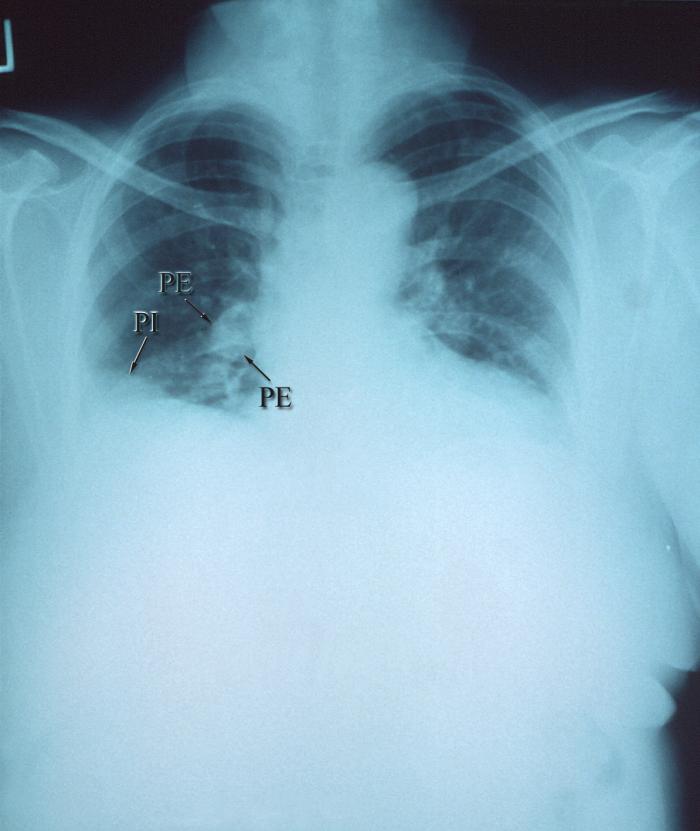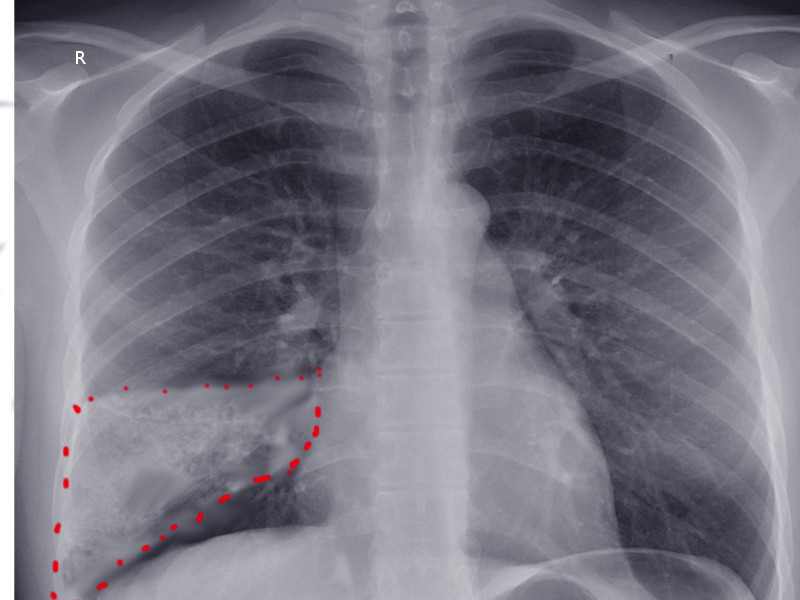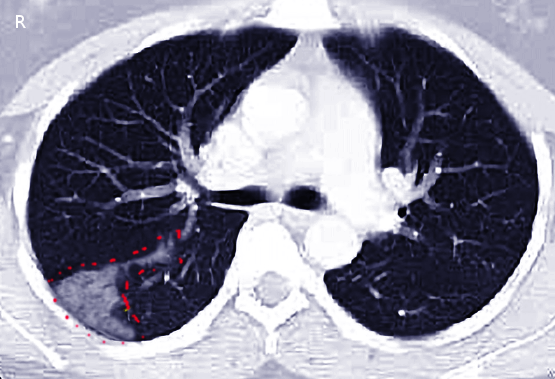[1]
Miniati M, Bottai M, Ciccotosto C, Roberto L, Monti S. Predictors of Pulmonary Infarction. Medicine. 2015 Oct:94(41):e1488. doi: 10.1097/MD.0000000000001488. Epub
[PubMed PMID: 26469892]
[2]
Islam M, Filopei J, Frank M, Ramesh N, Verzosa S, Ehrlich M, Bondarsky E, Miller A, Steiger D. Pulmonary infarction secondary to pulmonary embolism: An evolving paradigm. Respirology (Carlton, Vic.). 2018 Mar 25:():. doi: 10.1111/resp.13299. Epub 2018 Mar 25
[PubMed PMID: 29577524]
[3]
Chengsupanimit T, Sundaram B, Lau WB, Keith SW, Kane GC. Clinical characteristics of patients with pulmonary infarction - A retrospective review. Respiratory medicine. 2018 Jun:139():13-18. doi: 10.1016/j.rmed.2018.04.008. Epub 2018 Apr 17
[PubMed PMID: 29857996]
Level 2 (mid-level) evidence
[4]
Parambil JG, Savci CD, Tazelaar HD, Ryu JH. Causes and presenting features of pulmonary infarctions in 43 cases identified by surgical lung biopsy. Chest. 2005 Apr:127(4):1178-83
[PubMed PMID: 15821192]
Level 3 (low-level) evidence
[5]
Kaptein FHJ, Kroft LJM, Hammerschlag G, Ninaber MK, Bauer MP, Huisman MV, Klok FA. Pulmonary infarction in acute pulmonary embolism. Thrombosis research. 2021 Jun:202():162-169. doi: 10.1016/j.thromres.2021.03.022. Epub 2021 Apr 1
[PubMed PMID: 33862471]
[6]
Morgenthaler TI, Ryu JH, Utz JP. Cavitary pulmonary infarct in immunocompromised hosts. Mayo Clinic proceedings. 1995 Jan:70(1):66-8
[PubMed PMID: 7808055]
[7]
George CJ, Tazelaar HD, Swensen SJ, Ryu JH. Clinicoradiological features of pulmonary infarctions mimicking lung cancer. Mayo Clinic proceedings. 2004 Jul:79(7):895-8
[PubMed PMID: 15244386]
[8]
Terry PB, Buescher PC. Pulmonary Infarction: In the Beginning: The Natural History of Pulmonary Infarction. Chest. 2017 Dec:152(6):1135-1139. doi: 10.1016/j.chest.2017.07.005. Epub 2017 Jul 14
[PubMed PMID: 28716646]
[9]
Knight J, Murphy TM, Browning I. The lung in sickle cell disease. Pediatric pulmonology. 1999 Sep:28(3):205-16
[PubMed PMID: 10495338]
[10]
Yousem SA. The surgical pathology of pulmonary infarcts: diagnostic confusion with granulomatous disease, vasculitis, and neoplasia. Modern pathology : an official journal of the United States and Canadian Academy of Pathology, Inc. 2009 May:22(5):679-85. doi: 10.1038/modpathol.2009.20. Epub 2009 Mar 13
[PubMed PMID: 19287460]
[11]
Miniati M. Pulmonary Infarction: An Often Unrecognized Clinical Entity. Seminars in thrombosis and hemostasis. 2016 Nov:42(8):865-869
[PubMed PMID: 27743556]
[12]
Dalen JE, Haffajee CI, Alpert JS 3rd, Howe JP, Ockene IS, Paraskos JA. Pulmonary embolism, pulmonary hemorrhage and pulmonary infarction. The New England journal of medicine. 1977 Jun 23:296(25):1431-5
[PubMed PMID: 865513]
[13]
Tsao MS, Schraufnagel D, Wang NS. Pathogenesis of pulmonary infarction. The American journal of medicine. 1982 Apr:72(4):599-606
[PubMed PMID: 6462058]
[14]
Wiener RS, Schwartz LM, Woloshin S. Time trends in pulmonary embolism in the United States: evidence of overdiagnosis. Archives of internal medicine. 2011 May 9:171(9):831-7. doi: 10.1001/archinternmed.2011.178. Epub
[PubMed PMID: 21555660]
[15]
Søgaard KK, Schmidt M, Pedersen L, Horváth-Puhó E, Sørensen HT. 30-year mortality after venous thromboembolism: a population-based cohort study. Circulation. 2014 Sep 2:130(10):829-36. doi: 10.1161/CIRCULATIONAHA.114.009107. Epub 2014 Jun 26
[PubMed PMID: 24970783]
[16]
Kroegel C, Reissig A. Principle mechanisms underlying venous thromboembolism: epidemiology, risk factors, pathophysiology and pathogenesis. Respiration; international review of thoracic diseases. 2003 Jan-Feb:70(1):7-30
[PubMed PMID: 12584387]
[17]
Choi SH, Cha SI, Shin KM, Lim JK, Yoo SS, Lee SY, Lee J, Kim CH, Park JY, Lee DH. Clinical Relevance of Pleural Effusion in Patients with Pulmonary Embolism. Respiration; international review of thoracic diseases. 2017:93(4):271-278. doi: 10.1159/000457132. Epub 2017 Feb 15
[PubMed PMID: 28196360]
[18]
Vichinsky EP, Neumayr LD, Earles AN, Williams R, Lennette ET, Dean D, Nickerson B, Orringer E, McKie V, Bellevue R, Daeschner C, Manci EA. Causes and outcomes of the acute chest syndrome in sickle cell disease. National Acute Chest Syndrome Study Group. The New England journal of medicine. 2000 Jun 22:342(25):1855-65
[PubMed PMID: 10861320]
[19]
Emmi G, Silvestri E, Squatrito D, Amedei A, Niccolai E, D'Elios MM, Della Bella C, Grassi A, Becatti M, Fiorillo C, Emmi L, Vaglio A, Prisco D. Thrombosis in vasculitis: from pathogenesis to treatment. Thrombosis journal. 2015:13():15. doi: 10.1186/s12959-015-0047-z. Epub 2015 Apr 16
[PubMed PMID: 25883536]
[20]
Bajaj N, Bozarth AL, Guillot J, Kojokittah J, Appalaneni SR, Cestero C, Amankona RK, Pippim JA. Clinical features in patients with pulmonary embolism at a community hospital: analysis of 4 years of data. Journal of thrombosis and thrombolysis. 2014 Apr:37(3):287-92. doi: 10.1007/s11239-013-0942-8. Epub
[PubMed PMID: 23681675]
[21]
Revel MP, Triki R, Chatellier G, Couchon S, Haddad N, Hernigou A, Danel C, Frija G. Is It possible to recognize pulmonary infarction on multisection CT images? Radiology. 2007 Sep:244(3):875-82
[PubMed PMID: 17709834]
[22]
Hogg K, Brown G, Dunning J, Wright J, Carley S, Foex B, Mackway-Jones K. Diagnosis of pulmonary embolism with CT pulmonary angiography: a systematic review. Emergency medicine journal : EMJ. 2006 Mar:23(3):172-8
[PubMed PMID: 16498151]
Level 1 (high-level) evidence
[23]
Worsley DF, Alavi A, Aronchick JM, Chen JT, Greenspan RH, Ravin CE. Chest radiographic findings in patients with acute pulmonary embolism: observations from the PIOPED Study. Radiology. 1993 Oct:189(1):133-6
[PubMed PMID: 8372182]
[24]
Habib G. Embolic risk in subacute bacterial endocarditis: determinants and role of transesophageal echocardiography. Current cardiology reports. 2003 Mar:5(2):129-36
[PubMed PMID: 12583856]
[25]
Kearon C, Akl EA, Ornelas J, Blaivas A, Jimenez D, Bounameaux H, Huisman M, King CS, Morris TA, Sood N, Stevens SM, Vintch JRE, Wells P, Woller SC, Moores L. Antithrombotic Therapy for VTE Disease: CHEST Guideline and Expert Panel Report. Chest. 2016 Feb:149(2):315-352. doi: 10.1016/j.chest.2015.11.026. Epub 2016 Jan 7
[PubMed PMID: 26867832]
[26]
Jaff MR, McMurtry MS, Archer SL, Cushman M, Goldenberg N, Goldhaber SZ, Jenkins JS, Kline JA, Michaels AD, Thistlethwaite P, Vedantham S, White RJ, Zierler BK, American Heart Association Council on Cardiopulmonary, Critical Care, Perioperative and Resuscitation, American Heart Association Council on Peripheral Vascular Disease, American Heart Association Council on Arteriosclerosis, Thrombosis and Vascular Biology. Management of massive and submassive pulmonary embolism, iliofemoral deep vein thrombosis, and chronic thromboembolic pulmonary hypertension: a scientific statement from the American Heart Association. Circulation. 2011 Apr 26:123(16):1788-830. doi: 10.1161/CIR.0b013e318214914f. Epub 2011 Mar 21
[PubMed PMID: 21422387]
[27]
Frank Peacock W, Coleman CI, Diercks DB, Francis S, Kabrhel C, Keay C, Kline JA, Manteuffel J, Wildgoose P, Xiang J, Singer AJ. Emergency Department Discharge of Pulmonary Embolus Patients. Academic emergency medicine : official journal of the Society for Academic Emergency Medicine. 2018 Sep:25(9):995-1003. doi: 10.1111/acem.13451. Epub 2018 Jun 11
[PubMed PMID: 29757489]
[28]
Raj R, Raparia K, Lynch DA, Brown KK. Surgical Lung Biopsy for Interstitial Lung Diseases. Chest. 2017 May:151(5):1131-1140. doi: 10.1016/j.chest.2016.06.019. Epub 2016 Jul 26
[PubMed PMID: 27471113]
[29]
Winokur RS, Pua BB, Sullivan BW, Madoff DC. Percutaneous lung biopsy: technique, efficacy, and complications. Seminars in interventional radiology. 2013 Jun:30(2):121-7. doi: 10.1055/s-0033-1342952. Epub
[PubMed PMID: 24436527]



